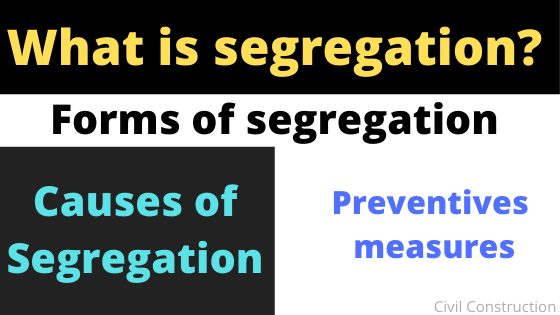Table of Contents
Segregation of concrete:
Segregation is the process of separation of ingredient material of concrete to make the heterogeneous mixture of freshly prepared concrete mix within a batch. Coarse aggregate, fine aggregate or cement paste separate from the concrete mix. Segregation can occurs at any stage of working as it may occurs during proportioning, mixing, transporting, placing and finishing. Segregation may cause the concrete weaker, less durable and will leave a poor surface finish.
We can found two forms of segregation;
1. The coarse aggregate separate out and settle down from rest of mix. This types of segregation occurs in too dry mix.
2. The concrete grout (cement+ water) separate out from rest of the mix being a material of lowest specific gravity. This types of segregation occurs in too wet mix.
Causes of segregation:
Segregation of concrete may be happened when the concrete is mixed, transported, placed or compacted.
A well-made concrete with consideration of various parameters like grading, size, shape and surface texture of aggregates with excess in quantity of water makes a cohesive mix. Maximum size of coarse aggregate greater than 25 mm have greater chance of segregation.
Improperly mixed concrete with excess water content; concrete discharged from a badly designed mixer, or from a mixer with wiped out blades shows a better tendency for segregate.
The opposite situations promoting segregation of concrete are Conveyance of concrete by conveyor belts, wheel barrow, long distance haul by dumper, long lift by skip and hoist.
Dropping of concrete as in case of casting of concrete column will result in segregation. If placing concrete straight from a truck, pour concrete mix vertically. Immediate performing on the concrete on placing, with none interval , is probably going to press the coarse aggregate down, which ends up within the movement of more than matrix or paste to the surface. Excess mortar at the top causes plastic shrinkage cracks.
It should be remembered that only comparatively dry mix should be vibrated for compaction. If the vibration is sustained for an extended time, particularly, in too wet a mixture , it’s likely to end in segregation of concrete thanks to settlement of coarse aggregate in matrix.
Preventive measures:
The tendency for segregation are often remedied by correctly proportioning the combination , by proper handling, transporting, placing, compacting and finishing. The proper uniform dry mixing of cement and aggregate, use of proper shape (angular and broken) and size(less than 25 mm) of coarse aggregate reduce the possibility of segregate.
- Concrete is mixed at the correct speed in a transit mixer for at least two minutes immediately prior to discharge. When transporting the mix, load and place carefully
- The height of drop of fresh concrete mix should be limited to 1.5 m. Always pour new concrete into the face of concrete already in situ .
- Vibration is continued just for required time (not more 2-3 minutes depending upon the thickness of structural member) for optimum results.
- Never spread concrete sideways with a poker vibrator. Always be sure to vibrate concrete evenly.
- Never make concrete mix too wet and too dry.
- Use certain work ability agents and pozzolanic materials.
- The use of air-entraining agent appreciably reduces segregate.
How to measure segregation?
It is very difficult to measure segregation quantitatively but at the time of concreting operation, it can be easily observed. The pattern of subsidence of concrete in slump test or the pattern of spread within the flow test gives a good idea of the standard of concrete with respect to segregation.
ALSO READ:
Bleeding of concrete:
Bleeding of concrete is the particular form of segregation in which some form of water appear in the surface of fresh concrete after it has consolidated and before it is set. Bleeding is predominantly observed during a highly wet mix, badly proportioned and insufficiently mixed concrete. Click here to read more . . . . .

